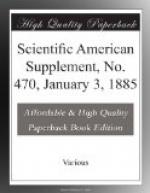to a minuteness without conceivable limit, in effect,
a minuteness that is beyond all finite measure or
conception. So that, as modern physics and optics
have enabled us not to conceive merely, but to actually
realize, the vastness of spatial extension, side by
side with subtile tenuity and extreme divisibility
of matter, so the labor, enthusiasm, and perseverance
of thirty years, stimulated by the insight of a rare
and master mind, and aided by lenses of steadily advancing
perfection, have enabled the student of life-forms
not simply to become possessed of an inconceivably
broader, deeper, and truer knowledge of the great
world of visible life, of which he himself is a factor,
but also to open up and penetrate into a world of
minute living things so ultimately little that we cannot
adequately conceive them, which are, nevertheless,
perfect in their adaptations and wonderful in their
histories. These organisms, while they are the
least, are also the lowliest in nature, and are to
our present capacity totally devoid of what is known
as organic structure, even when scrutinized with our
most powerful and perfect lenses. Now these organisms
lie on the very verge and margin of the vast area
of what we know as living. They possess the essential
properties of life, but in their most initial state.
And their numberless billions, springing every moment
into existence wherever putrescence appeared, led
to the question, How do they originate? Do they
spring up
de novo from the highest point on
the area of
not-life, which they touch?
Are they, in short, the direct product of some yet
uncorrelated force in nature, changing the dead, the
unorganized, the not-living, into definite forms of
life? Now this is a profound question, and that
it is a difficult one there can be no doubt. But
that it is a question for our laboratories is certain.
And after careful and prolonged experiment and research
the legitimate question to be asked is, Do we find
that, in our laboratories and in the observed processes
of nature now, the not-living can be, without the
intervention of living things, changed into that which
lives?
To that question the vast majority of practical biologists
answer without hesitancy, No, we have no facts
to justify such a conclusion. Prof. Huxley
shall represent them. He says: “The
properties of living matter distinguish it absolutely
from all other kinds of things;” and, he continues,
“the present state of our knowledge furnishes
us with no link between the living and the not-living.”
Now let us carefully remember that the great doctrine
of Charles Darwin has furnished biology with a magnificent
generalization; one indeed which stands upon so broad
a basis that great masses of detail and many needful
interlocking facts are, of necessity, relegated to
the quiet workers of the present and the earnest laborers
of the years to come. But it is a doctrine which
cannot be shaken. The constant and universal
action of variation, the struggle for existence, and




